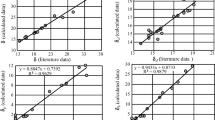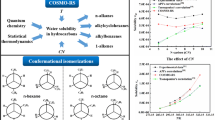Methods are examined for estimating the Hildebrand solubility parameter of a mixture of organic solvents using the characteristics of their structural elements. A procedure is proposed for calculating the solubility parameter for mixtures of solvents differing in composition and structure depending on the ratio of their components. These results enable us to predict the optimal solvent mixture composition for polymers with a known Hildebrand solubility parameter. The proposed method permits us to estimate the solubility of complex mixtures of hydrocarbons of petroleum origin such as the tar obtained as the vacuum residue of oil distillation when it is used as a polymer solvent. 1H NMR analysis results were used to determine the structural elements of a tar and calculate its Hildebrand solubility parameter.





Similar content being viewed by others
References
G. A. Kalabin, L. V. Kanitskaya, and D. F. Kushnarev, Quantitative NMR Spectroscopy of Organic Raw Materials and Products of Their Treatment [in Russian], Khimiya, Moscow (2000), pp. 84‑90.
A. K. Kuznetsov and I. M. Zakharova, Polymer Physical Chemistry Laboratory Textbook [in Russian], Ivanovo State Chemical Technological University, Ivanovo (2007), p. 49.
A. A. Askadskii and Yu. I. Matveev, The Chemical Structure and Physical Properties of Polymers [in Russian], Khimiya, Moscow (1983), pp. 190‑210.
A. M. Gyul’maliev, L. A. Zekel’, A. U. Dandaev, et al., Zhurnal Prikladnoi Khimii, 94, No. 1, 55‑63 (20210>
A. A. Tager, The Physical Chemistry of Polymers [in Russian], Khimiya, Moscow (1968).
S. Madorsky, Thermal Degradation of Organic Polymers [Russian translation], Mir, Moscow (1967), pp. 103‑141.
D. Stahl, E. Westrum, and G. Zinke, Chemical Thermodynamics of Organic Compounds [Russian translation], Mir, Moscow (1971), pp. 272‑343.
J. L. White and D. D. Choi, Polyethylene, Polypropylene and Other Polyolefins [Russian translation], Professiya, St. Petersburg (2006), pp. 13‑18.
Acknowledgements
This study was carried out at the Institute of Petrochemical Synthesis of the Russian Academy of Sciences in the framework of a grant of the Russian Science Fund (Project No. 17‑73‑30046).
Author information
Authors and Affiliations
Corresponding author
Additional information
Translated from Khimiya i Tekhnologiya Topliv i Masel. No. 2. pp. 32–37 March– April. 2023.
Rights and permissions
Springer Nature or its licensor (e.g. a society or other partner) holds exclusive rights to this article under a publishing agreement with the author(s) or other rightsholder(s); author self-archiving of the accepted manuscript version of this article is solely governed by the terms of such publishing agreement and applicable law.
About this article
Cite this article
Gyul’maliev, A.M., Batov, A.E., Zekel’, L.A. et al. Estimation of the Hildebrand Solubility Parameter of a Mixture of Petroleum‑Derived Solvents Using Their Structural Elements. Chem Technol Fuels Oils 59, 261–268 (2023). https://doi.org/10.1007/s10553-023-01525-5
Published:
Issue Date:
DOI: https://doi.org/10.1007/s10553-023-01525-5




